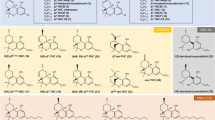Abstract.
The role of Na+ in the recognition of blockers by the dopamine transporter is accomodated by a model with a cation site that overlaps with the blocker binding domain, and a distal Na+ site that interacts with this cation site and perhaps with the blocker binding domain itself. The present study addresses the application of this model to the recognition of substrates by the dopamine transporter, focusing on conditions that should reveal a stimulatory effect, if present, of Na+ on substrate binding. Recognition was studied via the inhibition of binding of [3H]WIN 35,428 (2β-carbomethoxy-3β-(4-fluorophenyl) [3H]tropane), a cocaine analog, to the human dopamine transporter in human embryonic kidney 293 cells. Little or no changes in binding were noted for dopamine, d-amphetamine, p-tyramine, or dl-octopamine by increasing [Na+] from 2 mM to 20 mM with co-varying Br–, both at pH 7.4 and 7.0. In 74-mM Tris-HBr or -HCl, only dopamine and d-amphetamine showed binding increases upon raising Na+, leveling off with NO3 – or SO4 2– but not Br– as anion at ~60 mM Na+, consonant with a partly stimulatory action of Br–. An Na+ free, low 5-mM Tris-HEPES buffer was used for studying Na+ curves truly starting at 0 mM, and, with SO4 2– as the anion, no stimulation of binding by Na+ was observed. This suggested that the stimulations observed in high (74 mM) Tris+ buffer by Na+ were not a direct effect of Na+ but rather a disinhibitory effect of Na+ in removing Tris+ inhibition that depended upon substrate. Tris+ IC50 values in Na+ free buffer were not lower for dopamine and d-amphetamine than p-tyramine and dl-octopamine. No evidence was found for a stronger inhibitory effect of Na+ for dopamine and dl-octopamine potentially offsetting Tris+ disinhibition. All results together support the existence of a substrate domain overlapping with a cation site that also binds Tris+; a distal Na+ site interacts with this cation site and with the substrate domain by negative allosterism and is additionally impacted by Cl–. Importantly, interactions between sites vary with the type of substrate, and, in membrane preparations, Na+ is not required for, or stimulatory to, the binding of any of the four substrates studied unlike the binding of the cocaine analog WIN 35,428.
Similar content being viewed by others
Author information
Authors and Affiliations
Additional information
Electronic Publication
Rights and permissions
About this article
Cite this article
Li, LB., Cui, XN. & Reith, M.E. Is Na+ required for the binding of dopamine, amphetamine, tyramine, and octopamine to the human dopamine transporter?. Naunyn-Schmiedeberg's Arch Pharmacol 365, 303–311 (2002). https://doi.org/10.1007/s00210-001-0526-6
Received:
Accepted:
Issue Date:
DOI: https://doi.org/10.1007/s00210-001-0526-6




